Copy and Customize an Existing Giving Page
Learning Objectives
After completing this unit, you’ll be able to:
- Copy and modify a Giving Page.
- Add URL parameters to modify ask amounts.
New Requirements, and a New Giving Page
At the (fictional) nonprofit No More Homelessness (NMH), Development Associate Sofia is ready to copy the Giving Page she recently created to make a new version specifically for an email campaign.
NMH wants to use the new Giving Page to get more recurring donations. Specifically, NMH is hoping to convert its newsletter recipients who have given at least one gift in the last 12 months, but don’t have an ongoing recurring donation.
The page will be stand-alone because it will be shared via link through an email, where NMH will make its entire case for support. The new requirements also mean there will be a few other modifications to the page, but not enough that Sofia has to start from scratch.
Copy the Giving Page
Sofia starts by making a copy of the existing page.
- In the Elevate Admin Console, click Giving Page Management. It’s the heart icon (
 ).
).
- Find the existing page—in this case, NMH Annual Fund Page (Embedded)—and click the three-dot menu button (
 ) next to the name.
) next to the name.
- Click Duplicate.
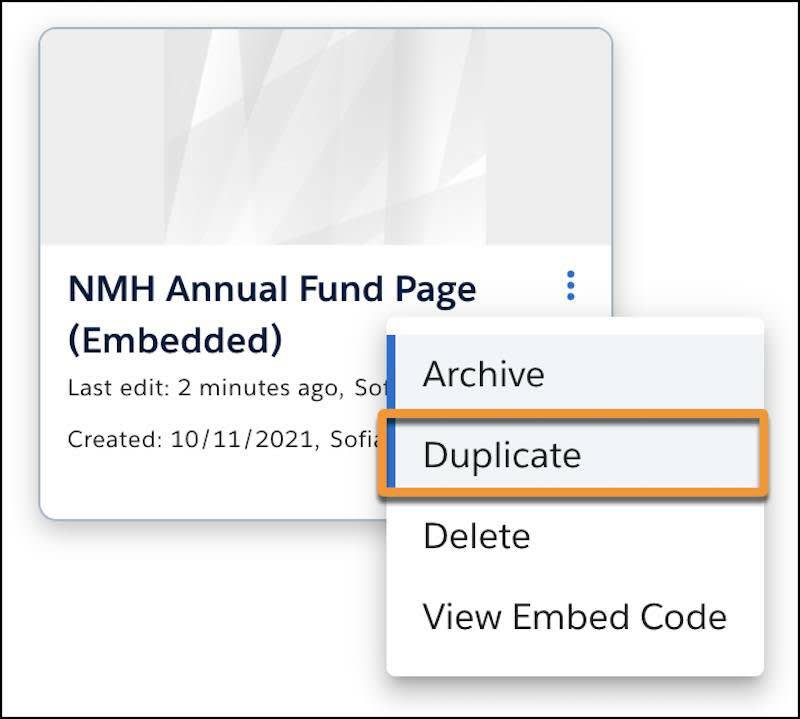
This will open a copy of the Giving Page, starting with General Settings.
Change General Settings
We need to change a few General Settings about the page to make it work best as a stand-alone page.
Under the General subtab, Sofia makes these updates:
- Name:
NMH Annual Fund Page (Newsletter to Recurring)to better label it internally.
- Giving Page URL: Edit the automatically generated URL to
give-monthly-to-help-end-homelessness. Because we plan to share this page with donors using the link, and the URL will be readily visible, we want something more user-friendly. Plus, this can have some search engine optimization (SEO) benefits. Just note that you can’t save a Giving Page if it has the same URL as another Giving Page in your Elevate instance.
- Title:
Support the NMH Annual Fund with a Recurring Gift
- Subtitle:
Help us make sure everyone has enough to eat and a safe place to live.
- Background image: Sofia adds a program shot to show the work NMH does. Because this page will be stand-alone and not embedded, NMH wants to make sure it does everything it can to make the page compelling and visually appealing.
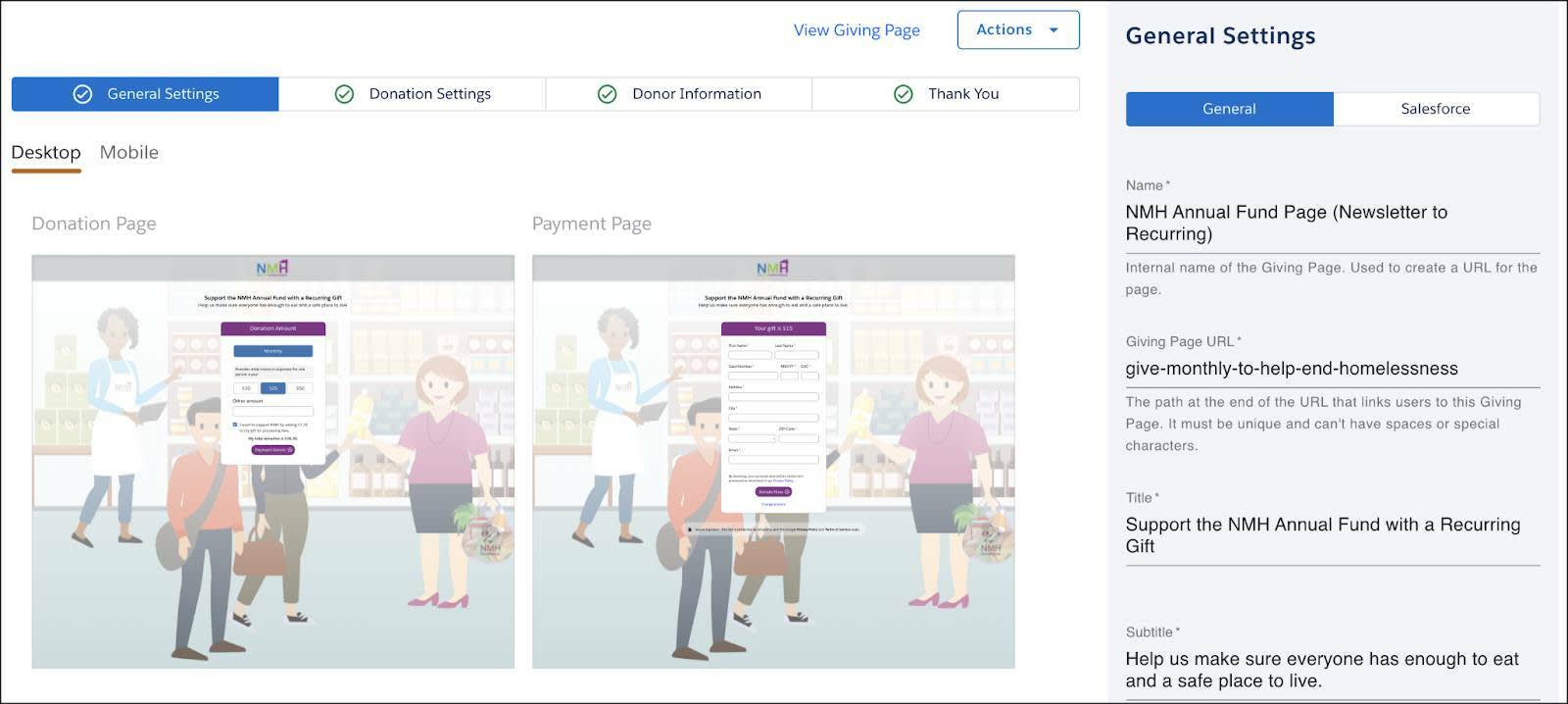
Next, click the Salesforce subtab.
Sofia pastes in a new campaign ID. For this effort, Sofia created a Salesforce campaign and added donors who meet NMH’s criteria (they receive the newsletter, gave in the last 12 months, and don’t have an associated recurring donation). When a donor in that campaign gives, their campaign member status will change to Responded.
New opportunities are also associated with the campaign to collect reporting and summary information to track its effectiveness.
With the new campaign ID in place, click Save & Continue.
Change Donation Settings
In Donation Settings, Sofia has a few more changes to make.
- Click Donation Settings in the Giving Page Management navigation.
- Click Frequency Options.
- Click Remove in the One-Time frequency box.
- Click Remove again in the Yearly frequency box, leaving only Monthly.
- Click Save.
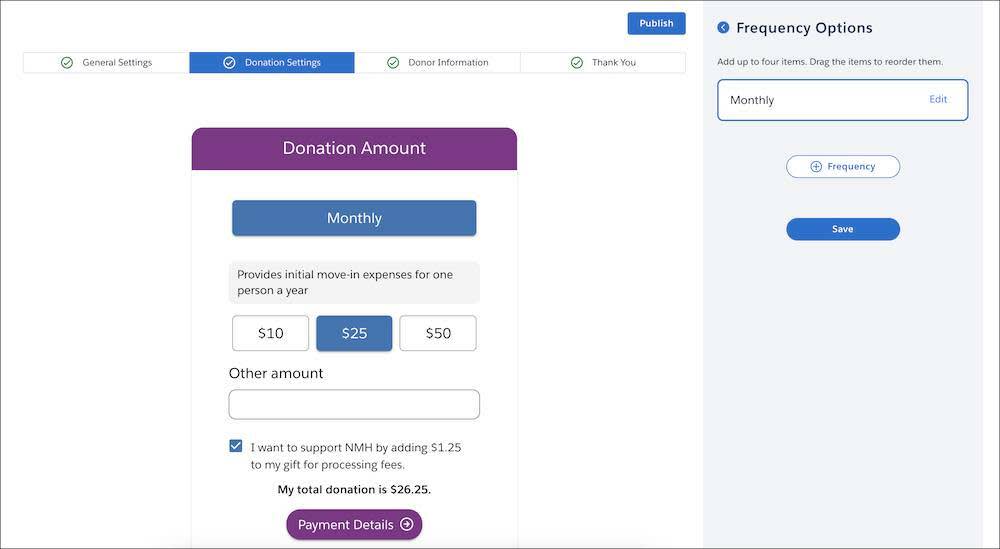
Sofia will leave the three default donation amounts for the Monthly frequency. The defaults are fine, and she plans to customize the ask ladder for each donor using URL parameters. More on that in a moment.
She’ll also leave the Admin Defined Designation and Donor Cover settings alone.
Change Donor Information
Next, we need to modify the Donor Information settings.
- Click Donor Information in the Giving Page Management navigation.
- Under the Standard subtab:
- Turn off Consent Opt-In. We know these donors already receive the email newsletter, so we don’t need to include that here.
- Turn on Address, City, State, and ZIP Code. NMH does special mailings to its recurring donors, and they want to collect addresses if they don’t already have them stored in contact records in Salesforce.
- Click the Custom subtab.
- Sofia starts by removing the custom field for volunteer interest. She doesn’t need that now.
- Click Opportunity.
- Click Description, which is already mapped from Salesforce to Elevate by default.
- Sofia wants to make this a hidden field to store some details about this campaign on any completed donations. Here’s what she does:
- Select the Hidden checkbox.
- Default Value: Enter
Converted from one-time donor to sustainer. NMH will change this value with URL parameters.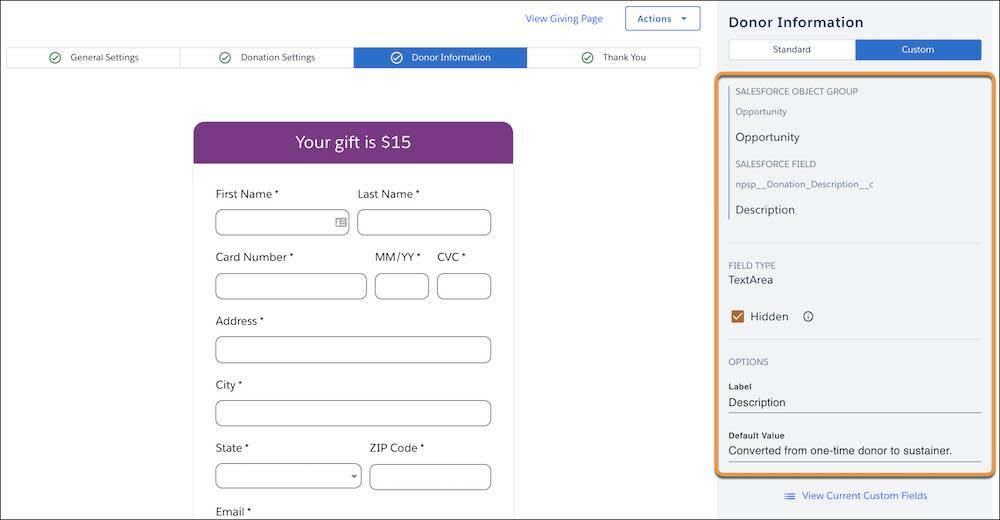
- Click Save.
Customize the Confirmation
Now, just a slight modification to the Thank You page.
- Click Thank You in the Giving Page Management navigation.
- Change the Custom Message to mention that this is a recurring donation:
Thank you for supporting NMH with a recurring donation!
- Click Save.
Review and Publish
That’s it! The changes are in place and it’s time to publish the page and get the link for our next steps.
- Click General Settings in the Giving Page Management navigation to review the page previews for desktop and mobile.
- Publish the page.
- Optionally, you can click View Giving Page to preview what your donors will experience on the page.
- Click the Actions menu button.
- Click Copy Giving Page Link.
Remember, this will be sent as an email campaign, so we only need the link. But it won’t just be the link we send—we’re going to use the URL parameters we’ve been talking about to make this page really sing.
Configure URL Parameters
URL parameters are powerful because they help you customize an Elevate Giving Page to any donor. You can create a special ask for them, fill in the fields with the information you already know about them, and collect extra information to hidden fields.
URL parameters are best paired with a marketing automation tool like Marketing Cloud Engagement to send personalized emails to many donors at once using information stored in their Salesforce contact and account records.
More detail on how to use URL parameters is located in documentation linked in the Resources section. For now, let’s review some of the URL parameters NMH and Sofia will use with their marketing automation tool, and then we’ll find out how the strategy paid off.
URL Parameter(s) |
Purpose |
How NMH Plans to Use It |
|---|---|---|
rba
|
Sets the recurring donations base amount for the calculated ask ladder. ( |
Set the base amount for each donor at 10% of their total gifts over the last 12 months, which is stored in a custom formula field in Salesforce. NMH hopes donors commit to the monthly amount, resulting in a 20-point increase in their giving over the next year. |
|
Populates the corresponding standard fields in the donor information page. |
Save the donor time by prefilling information that NMH already has in Salesforce and doesn’t need to collect again. A donor can change any of these values in the donation form to update them. |
customFields[npsp__Donation_Description__c]
|
Uses the Salesforce API name of the field in the NPSP Data Import object to feed information into Salesforce. This is the field we’re using for this example. |
Add description details to the hidden field and pass them to the opportunity record of completed donations. |
In her marketing automation tool, Sofia can use merge fields to fill in particular values for each of the parameters. So, together, the URL parameters for donor Lucy Alvarez might be:
?rba=100&firstName=Lucy&lastName=Alvarez&email=lalvaerez@mailinator.com&addressLine1=221B Baker Street&city=New York&state=NY&postalCode=92736&customFields[npsp__Donation_Description__c]=Newsletter subscriber and donor to recurring donor campaign. Send 1. 1.2inc.
Not that she would notice the parameters, of course. She’d just recognize how easy it was to give.
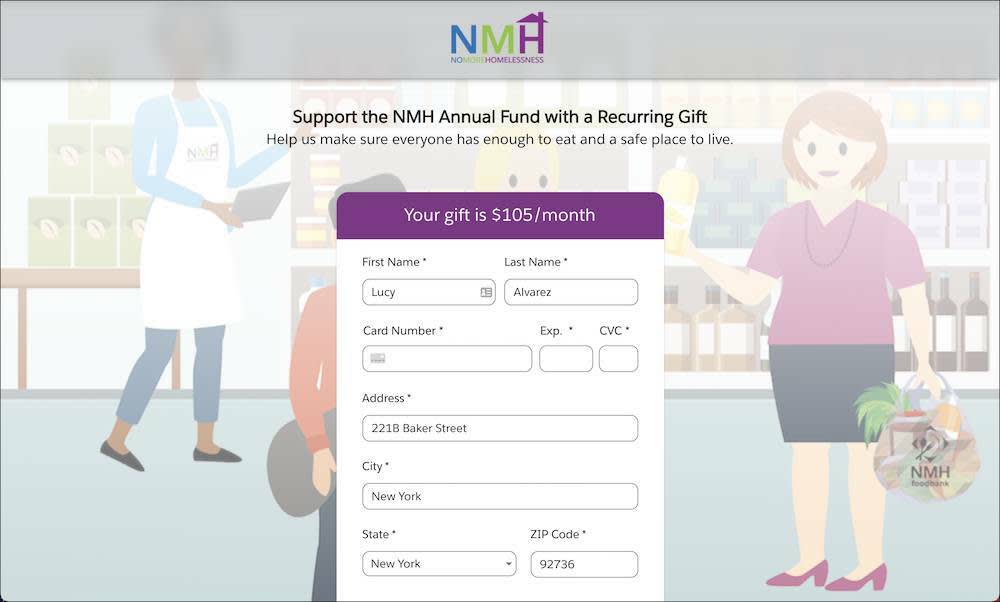
Using these parameters won’t just save donors time they would spend filling in details about themselves that NMH already knows. In NMH’s plan, it could also result in a 20-percentage-point increase in each donor’s annual giving with a tailored ask.
A New Strategy Pays Off

NMH sends the email to a small group of donors to test their concept, and results are promising. They decide to send it out to the entire group and wait for results.
By the end of the week, it’s clear that the new Giving Page is a success! The group beat their benchmark for monthly donor conversions and added a slew of new recurring donors. Aniyah, the Development Director, is happy to have a growing reliable base of revenue to start from each month—and is excited about the opportunity for more tests like this.
Elevate and Your Mission
In this module we covered how to set up two donation forms to meet NMH’s strategic fundraising goals. Now, how will you use your Elevate to meet your organization’s revenue targets and grow your mission?
Resources
-
Salesforce Help: Create or Edit a Giving Page
-
Salesforce Help: Populate a Giving Page with URL Parameters
